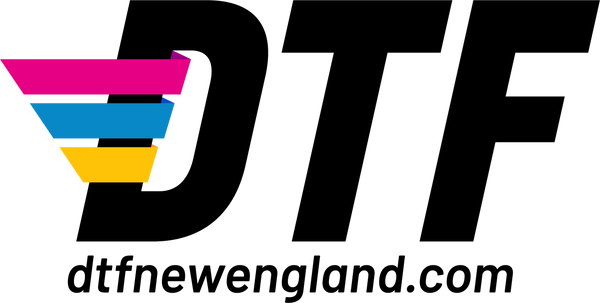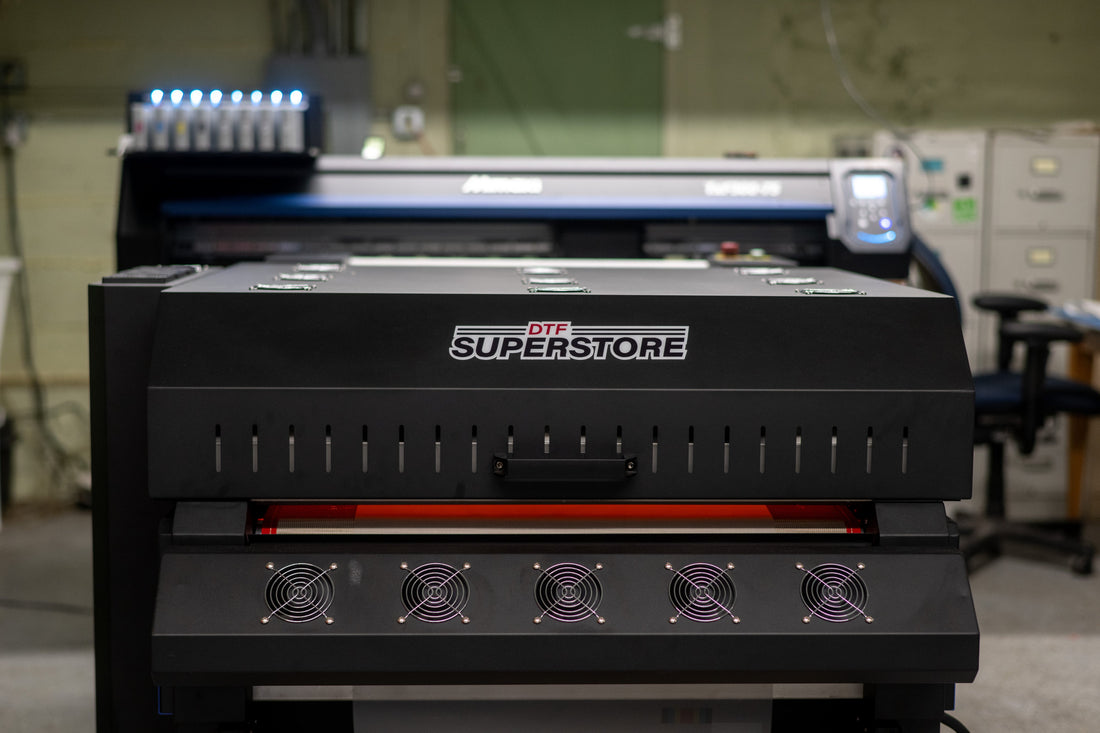Direct-to-Film (DTF) printing has taken the apparel world by storm. From small shops to large production facilities, more businesses are considering investing in a DTF printer to expand their capabilities. But with so many options on the market—and such a wide range of prices—how do you know which DTF printer is the right one for your business?
There are lots of options, and the “right” choice depends on volume, budget, space, and your long-term goals. This guide breaks it all down so you can make a smart, confident decision.
Understanding Direct-to-Film (DTF) Printers
A DTF printer is specialized for printing full-color designs onto a PET (polyethylene terephthalate) film. Unlike other printing methods, DTF uses aqueous pigmented inks, and the design is printed in reverse (mirrored), with white ink typically applied last to achieve opacity.
After printing, a hot-melt powder (typically polyurethane resin-based) is applied to the tacky white ink. The film then passes through a heat tunnel, where the powder is melted to bond it with the ink. Once cooled, the transfer is ready to be pressed onto fabric using heat.
Why DTF is gaining popularity:
-
Works on almost any fabric: cotton, polyester, blends, synthetics, even silk.
-
Unlimited colors and fine detail: no need to weed like vinyl.
-
No screen setup or complicated pre-treatment.
-
Ideal for both one-off designs and high-color, high-detail runs.
Compared to DTG (direct-to-garment), DTF typically requires less pre-treatment, supports a wider array of fabric types, and offers an attractive production cost per print, especially when scaled.
Factors to Consider When Choosing the Best DTF Printer
Investing in a DTF printer is a big decision, and it’s about much more than the initial price tag. The right printer can help your small business scale efficiently and produce high-quality transfers consistently, while the wrong choice can lead to frustration, wasted materials, and unexpected downtime.
Before committing to any machine, think carefully about how you plan to use it. Are you running a small shop that needs flexibility and manageable maintenance? Or are you building out a production line that runs all day? Your print volume, workspace, and staffing all play significant roles in determining which model fits your needs best.
Here are the key factors to evaluate:
-
Print Quality & Resolution: Look for printers capable of sharp, high-resolution output. Good white ink laydown and even powder coverage are crucial for vibrant transfers.
-
Speed & Volume: Entry-level DTF printers may manage only a few prints per hour, while more industrial machines can run much faster with high throughput.
-
Printer Size & Format:
-
- Hobbyists may opt for small A3-style or desktop DTF printers.
- Growing shops often prefer 24″ (or higher) roll-fed machines.
- Commercial setups may utilize 48″ or larger industrial models.
-
Maintenance & Usability: Regular cleaning is a must, especially for white ink systems. Some printers are more user-friendly and automated, while others require more manual maintenance.
-
Operating Cost & ROI: A decent entry-level setup can start around $5,000, while commercial printers often exceed $30,000—factor in ink, film, and powder when calculating real costs.
-
Support & Reliability: Having reliable service, good documentation, and a community helps, especially for newcomers.
Top-Rated DTF Printers in 2025
Choosing the best Direct-to-Film printer starts with understanding the level of production you need. Not every business requires a $30,000 setup, and not every compact printer can keep up with a shop printing hundreds of transfers a day.
When comparing the top-rated DTF printers in 2025, it is helpful to consider three main categories: entry-level, mid-range, and commercial-grade. Each category serves a unique purpose, from hobby printing and small-batch testing to full-scale apparel production. Below, we’ll break down what to expect at each level and share some standout models to guide your decision.
Best Entry-Level DTF Printers
Entry-level DTF printers are ideal for hobbyists, side hustlers, or anyone new to DTF printing. They’re compact, affordable, and simple to operate — perfect for testing designs, fulfilling small online orders, or producing transfers on demand.
Popular 2025 models in this category include the Procolored A3 DTF L1800, Sublistar A3 Mini, and Mimaki TxF150-75 (a small-format option praised for its color accuracy).

Pros:
- Lower upfront cost (around $5K–$8K)
- Smaller footprint, fits in most workspaces
-
Good option for testing designs or small batches
Cons:
- Slower output
-
Limited to small-scale operations
Best Mid-Range Printers for Growing Businesses
Mid-range printers hit the sweet spot for most small-to-medium shops. These 24” roll-fed machines offer professional-grade quality with better speed and reliability than entry-level models, without the steep investment of industrial setups.
Leading examples include the STS Mutoh VJ-628D, ColDesi DTF 24H2, and Sublistar 24” DTF PRO Max. These machines are known for balancing output speed, durability, and precision, making them ideal for businesses doing steady production.

Pros:
- Faster speeds with professional-quality results
- Handles higher volume for small businesses
-
Strong balance between cost and capability
Cons:
- Requires more maintenance
-
Larger size means more space is needed
Best High-End Commercial Printers
Commercial DTF printers are built for serious production: shops that handle large wholesale orders or run printing operations full-time. These 24” to 48” roll-fed powerhouses deliver unmatched speed, consistency, and precision, often with integrated drying and curing systems.
Top-tier options for 2025 include the Mimaki TxF300-75, Epson SureColor F2270, and Sublistar 48” DTF Industrial PRO, all capable of running thousands of transfers per week.

Pros:
- Fastest print speeds and highest capacity
- Consistent results on bulk orders
-
Designed for industrial-level production
Cons:
- $25K–$40K+ investment
- More complex upkeep and higher running costs
DTF Printer Comparison at a Glance
Before deciding which direction to take, it helps to see how these categories stack up side-by-side. Use the chart below to get a quick overview of what each printer type offers in terms of cost, performance, and practicality.
|
Printer Type |
Best For |
Price Range |
Pros |
Cons |
|
Entry-Level |
Hobbyists |
$5K–$8K |
Affordable, compact, beginner-friendly |
Slower, not for scaling |
|
Mid-Range |
Small Shops |
$8K–$20K |
Balanced cost, speed, and quality |
Needs more space & upkeep |
|
Commercial |
Large Businesses |
$25K–$40K+ |
High speed, consistent production |
Very expensive, complex care |
👉 Which one is right for you? For hobbyists, entry-level printers are an easy way to start. For small shops, mid-range printers usually deliver the best long-term value. But for many apparel businesses, outsourcing transfers to a trusted partner like DTF New England saves money, eliminates maintenance headaches, and ensures you always get professional, ready-to-press results.
Do You Really Need to Buy a DTF Printer?
Here’s the truth: while owning a printer can be appealing, outsourcing your DTF transfers is often the smarter move, especially for small-to-midsize businesses.
At DTF New England, we’ve made a big investment in top-tier DTF equipment, so you don’t have to. You avoid:
- The $25K–$40K+ upfront cost of a commercial DTF printer
- Daily maintenance, cleaning, and calibration headaches
- Downtime from clogs or production issues
Instead, you get:
- Same-day turnaround when you order before noon ET
- Free next-day air shipping on orders over $200
- High-quality, press-ready transfers that you can apply yourself
Order DTF Transfers and focus on growing your business while we handle the printing.
Best DTF Printer for Small Business Owners
If you run a small apparel business, it might feel tempting to buy the best DTF printer for small business, but ask yourself:
- Do I have enough volume to justify the machine cost?
- Can I handle maintenance, cleaning, and troubleshooting?
- How much space do I have for a printer, storage for film, and powder?
Often, partnering with a specialist like DTF New England is more cost-effective. We help print shops and apparel brands nationwide get professional-quality transfers without the hassle of owning equipment.
Final Thoughts
- There’s no one-size-fits-all answer to “what is the best DTF printer”: it depends on your needs.
- For many small businesses, the best direct-to-film printer is not owning one, but outsourcing to a trusted provider.
- At DTF New England, we simplify your process: you upload your designs, we print on PET film with pigmented ink + adhesive powder, cure it, and ship you press-ready sheets. Our same-day turnaround and free next-day air shipping (on orders over $200) make it fast, reliable, and scalable.
👉 Get started today and order your custom DTF transfers here.
FAQs
Does DTF need a specific printer?
Yes. DTF printers use aqueous pigmented inks + white ink, designed to print on PET film.
How do I make my own DTF transfers?
You need a DTF printer, PET film, hot-melt powder, and a heat press. After printing and powdering, you cure the film, then press it to the garment.
What type of printer is best for DTF transfers?
It depends. For personal projects, opt for an entry-level model; for a growing shop, select a mid-range roll-fed model; for high-volume needs, commercial printers are the best choice. But again, many businesses (including DTF New England) offer high-quality transfers without you ever purchasing a machine.

